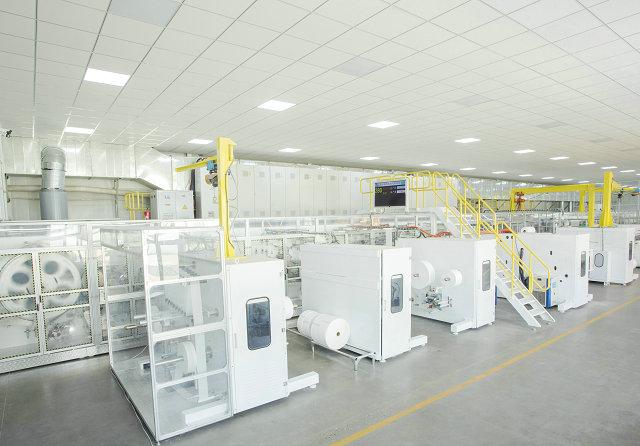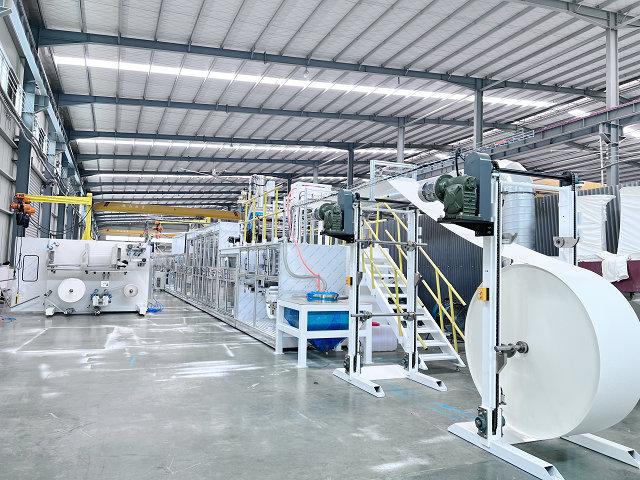Author:Haina Machinery Factory FROM:Diaper Machinery Manufacturer TIME:2024-11-29
Sanitary pad machines play a crucial role in the production of hygiene products that cater to millions of women worldwide. Understanding the production capacity of these machines is essential for manufacturers, investors, and stakeholders in the sanitary products industry. This article will delve into various aspects of sanitary pad machines, including their design, efficiency, and factors affecting production capacity, providing a comprehensive overview for those interested in the manufacturing process.
The design of a sanitary pad machine is integral to its production capacity. These machines typically comprise several components, including unwinding systems, feeding systems, cutting mechanisms, and packaging units. Each segment is engineered to streamline the production process, allowing for high-speed operation and minimal downtime. Advanced models incorporate automation technology, which not only enhances efficiency but also reduces labor costs. The configuration of these machines can significantly influence their output, making it crucial for manufacturers to select models that align with their production goals.

When assessing the production capacity of a sanitary pad machine, several metrics are commonly considered. The most straightforward measure is the number of pads produced per hour or day. High-capacity machines can produce anywhere from 100 to over 300 pads per minute, depending on the technology used and the complexity of the product being manufactured. Additionally, the operational efficiency percentage is another critical metric, which reflects how effectively the machine operates within its intended capacity. Manufacturers must evaluate these metrics to determine the viability of a machine for their specific needs.
Several factors can influence the production capacity of a sanitary pad machine. Firstly, raw material quality plays a significant role; inconsistent materials can lead to increased waste and reduced efficiency. Secondly, machine maintenance is vital. Regular upkeep ensures that the machinery runs smoothly, preventing breakdowns that could halt production. Thirdly, operator skill level affects performance; trained operators can optimize machine settings and troubleshoot issues more effectively. Lastly, the complexity of the sanitary pad design—such as the inclusion of wings or the use of different absorbent materials—can impact the speed of production.

Different types of sanitary pad machines cater to varying production capacities and product designs. For instance, there are fully automatic machines that handle the entire production process, from raw material unwinding to packaging. These machines often have a higher output due to their integration and efficiency. In contrast, semi-automatic machines may require manual intervention at certain stages, which can limit their production rate. Manufacturers must choose between these options based on their specific production demands and budget constraints.
The sanitary pad manufacturing industry is witnessing rapid advancements, with new technologies emerging that enhance production capacity. Innovations such as IoT-enabled machines allow real-time monitoring and analytics, enabling manufacturers to optimize their operations continuously. Furthermore, environmentally friendly materials and production processes are gaining traction, prompting manufacturers to adapt their machines accordingly. Keeping up with these trends is essential for companies aiming to remain competitive in a dynamic market.

Investing in a sanitary pad machine involves significant costs, and understanding the relationship between price and production capacity is crucial. While high-capacity machines may require a larger initial investment, they can lead to better long-term profitability due to lower per-unit production costs. Manufacturers should conduct a thorough cost-benefit analysis to assess the potential return on investment associated with different machines. This analysis should factor in not only the purchase price but also maintenance costs, operational efficiency, and expected output.
As consumer demand evolves, the future of sanitary pad machine production looks promising. With an increasing focus on sustainability and health, manufacturers are exploring ways to produce biodegradable and organic products. This shift may require modifications to existing machines or the development of new equipment altogether. Additionally, as global populations grow, the demand for hygienic products is expected to rise, creating opportunities for increased production capacities and new market entrants.
In summary, the production capacity of a sanitary pad machine is influenced by multiple factors, including design, raw materials, machine type, and operator skills. With advancements in technology and shifts in market demands, manufacturers must remain agile and informed to ensure their production capabilities meet evolving needs. By understanding these aspects, stakeholders can make informed decisions that will enhance their operational efficiency and product offerings, positioning themselves well for the future of the sanitary products industry.
